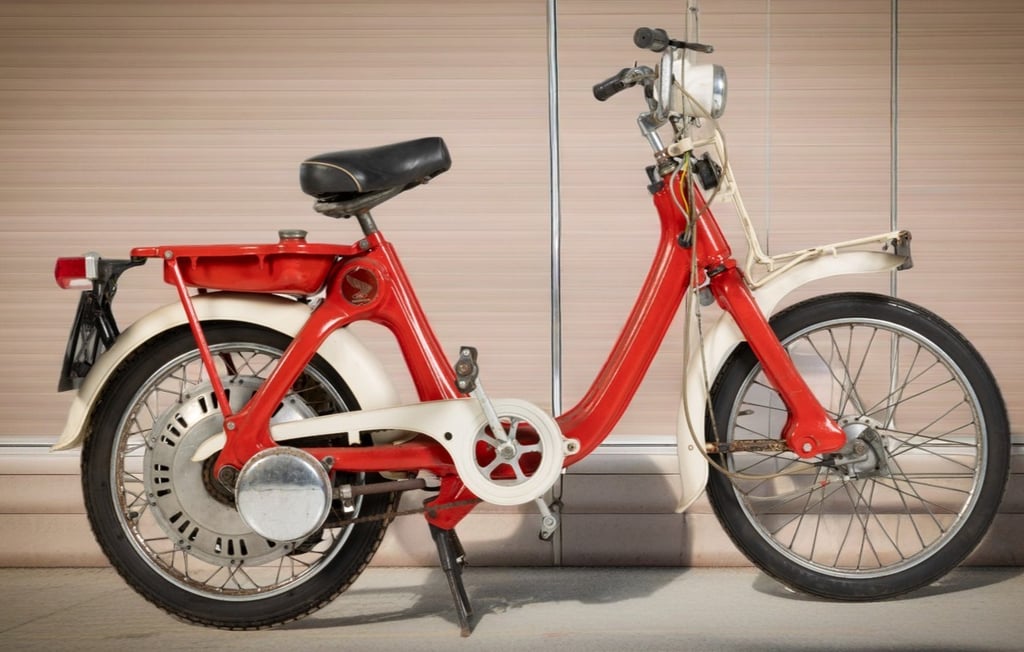1967 Honda P50 Moped: A Collector's Guide to a Timeless Icon
The 1967 Honda P50 moped, also known as the 'Little Honda P50', holds a special place in motorcycle history. With its unique design and four-stroke engine, it stood out from its two-stroke counterparts of the time. The P50 offered a smooth riding experience and played a significant role in establishing four-stroke engines as a standard in the industry. Today, it is highly sought after by collectors due to its rarity and historical significance.
JAPAN FOUR STROKEHONDA 1960'SVINTAGE MOPEDS
2/20/20243 min read


1967 Honda P50 Moped: A Collector's Guide to a Timeless Icon
Introduction
The Honda P50, affectionately known as the 'Little Honda P50' or P25 in some markets, embodies a significant slice of two-wheeled history. Introduced in June 1966 and produced until 1968, this moped remains a treasure for aficionados and a veritable relic of the past. While it may be challenging to spot one on today's streets, the P50 enjoys a cult status among collectors, with well-preserved models fetching high prices. As we turn back the pages of time, let us explore the charm and legacy of this quaint but influential moped.
Historical Backdrop and Inception
In the mid-1960s, the motorcycle industry was on the cusp of a revolution. It was in this era of transformation that Honda introduced the P50 moped, setting a new precedent for two-wheeled urban transport. Unlike the predominantly two-stroke mopeds of its time, the P50 stood out with its four-stroke engine, heralding reliability and efficiency. The P50's design was especially noteworthy; it was one of the last to feature the motor-in-wheel configuration, a throwback to designs like the 'Winged Wheel' by BSA two decades prior. The design choice not only distinguished the P50 from its counterparts but also marked the end of an era, making it a pivotal chapter in the evolution of two-wheeled vehicles.
Technical Specifications
The 1967 Honda P50, or Little Honda as it is endearingly called, features a singular design choice—the integration of engine and wheel, akin to the Cyclemaster style. This 49cc overhead cam, four-stroke, air-cooled engine could hit a top speed of around 25 mph, with a power output of 1.2 hp at 4,200 rpm and 1.81 lb-ft of torque at 2,500 rpm. Its continuous variable automatic transmission made for a smooth and accessible ride, perfectly suited for the urban environment of the time. The P50's step-through frame, leading-link front suspension, and lightweight build underpinned a user-friendly moped that distinguished itself from European contemporaries.
Riding Experience and Performance
The 1967 Honda P50 not only impressed with its technical specs, but also provided a delightful riding experience. Despite its petite stature, the moped's four-stroke engine ensured smooth acceleration and a comfortable, stable ride. Its automatic transmission and lightweight design meant handling was easy, even for novice riders, effectively lowering the entry barrier for motorized two-wheel transport. The P50's performance was modest by today's standards, but at the time, it was an accessible segue into personal mobility, receiving warm accolades from buyers for its convenience and reliability.
The Honda P50's Cultural Impact
The Honda P50 emerged in a time when mopeds were heavily synonymous with personal freedom and the joy of ride. Its distinctive engineering and charming design contributed notably to the moped culture of the 1960s, helping to solidify Honda's reputation as an innovator in the motorcycle industry. More than just a mode of transportation, the P50 represented a democratic vision of mobility, encapsulating Honda's philosophy of creating motorcycles for the masses. Its legacy is felt not only in the collector circles but also in how it helped to establish four-stroke engines as a standard, influencing the design and mechanics of future mopeds and motorcycles.
Legacy and Collector Interest
To the vintage vehicle enthusiast, the Honda P50 is more than just a moped—it's a cherished heirloom. The rarity of this model, coupled with its historical significance, has elevated it to a prized collectible. Restored and well-maintained P50s command considerable attention and high price tags in auctions and private sales. For collectors, the P50 represents an era of innovation and is a testament to Honda's legacy of quality and design. It's this nostalgia and the joy of owning a piece of motorcycle history that make the P50 a sought-after gem in any vintage collection.
